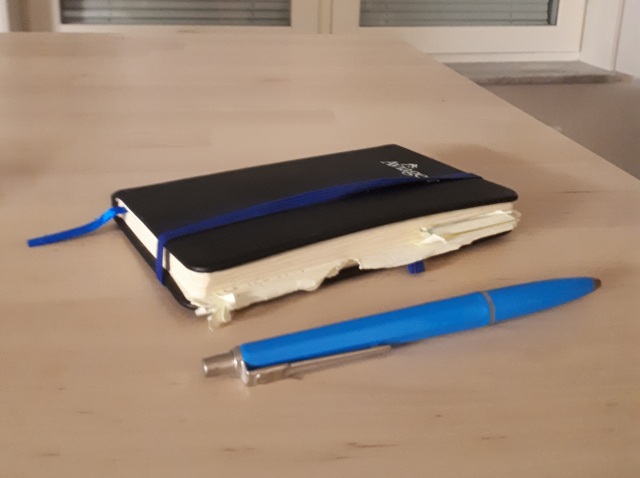Dear diary,
The last post was about my attempt to use the Getting Things Done method to bring some more order to research, work, and everything. This post will contain some more details about my system, at a little less than a year into the process, on the off chance that anyone wants to know. This post will use some Getting Things Done jargon without explaining it. There are many useful guides online, plus of course the book itself.
Medium
Most of my system lives in paper notebooks. The main notebook contains my action list, projects list, waiting for list and agendas plus a section for notes. I quickly learned that the someday/maybe lists won’t fit, so I now have a separate (bigger) notebook for those. My calendar is digital. I also use a note taking app for project support material, and as an extra inbox for notes I jot down on my phone. Thus, I guess it’s a paper/digital hybrid.
Contexts
I have five contexts: email/messaging, work computer, writing, office and home. There were more in the beginning, but I gradually took out the ones I didn’t use. They need to be few enough and map cleanly to situations, so that I remember to look at them. I added the writing context because I tend to treat, and schedule, writing tasks separately from other work tasks. The writing context also includes writing-adjacent support tasks such as updating figures, going through reviewer comments or searching for references.
Inboxes
I have a total of nine inboxes, if you include all the email accounts and messenger services where people might contact me about things I need to do. That sounds excessive, but only three of those are where I put things for myself (physical inbox, notes section of notebook, and notes app), and so far they’re all getting checked regularly.
Capture
I do most of my capture in the notes app on my phone (when not at a desk) or on piece of paper (when at my desk). When I get back to having in-person meetings, I assume more notes are going to end up in the physical notebook, because it’s nicer to take meeting notes on paper than on a phone.
Agendas
The biggest thing I changed in the new notebook was to dedicate much more space to agendas, but it’s already almost full! It turns out there are lots of things ”I should talk to X about the next time we’re speaking”, rather than send X an email immediately. Who knew?
Waiting for
This is probably my favourite. It is useful to have a list of who have said they will get back to me, when, and about what. That little date next to their name helps me not feel like a nag when I ask them again after a reasonable time, and makes me appreciate them more when they respond quickly.
Weekly review
I already had the habit of scheduling an appointment with myself on Fridays (or otherwise towards the end of the week) to go over some recurring items. I’ve expanded this appointment to do a weekly review of the notebook, calendar, someday/maybe list, and some other bespoke checklist items. I bribe myself with sweets to support this habit.
Things I’d like to improve
Here are some of the things I want to improve:
- The project list. A project sensu Getting Things Done can be anything from purchase new shoes to taking over the world. The project list is supposed to keep track of what you’ve undertaken to do, and make sure you have come up with actions that progress them. My project list isn’t very complete, and doesn’t spark new actions very often.
- Project backlogs. On the other hand, I have some things on the project list that are projects in a greater sense, and will have literally thousands of actions, both from me and others. These obviously need planning ahead beyond the next thing to do. I haven’t yet figured out the best way to keep a backlog of future things to do in a project, potentially with dependencies, and feed them into my list of things to do when they become current.
- Notes. I have a strong note taking habit, but a weak note reading habit. Essentially, many of my notes are write-only; this feels like a waste. I’ve started my attempts to improve the situation with meeting notes: trying to take five minutes right after a meeting (if possible) to go over the notes, extract any calendar items, actions and waiting-fors, and decide whether I need to save the note or if I can throw it away. What to do about research notes from reading and from seminars is another matter.
